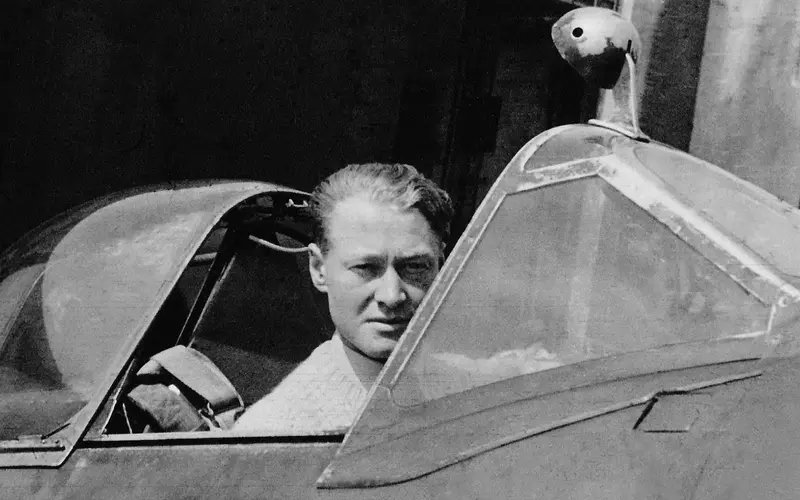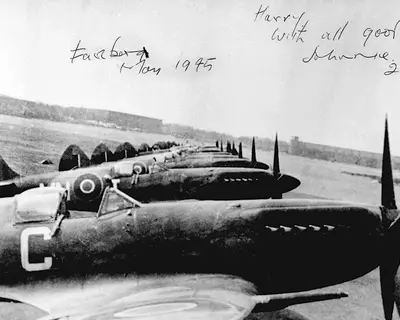Group Captain Harold Walmsley (1934 - 1938)
Group Captain Harold Walmsley was one of the last surviving Spitfire ‘aces’ of the Second World War; he joined 130 Squadron as a flight commander in October 1944 when it was based in Normandy flying the latest mark of Spitfire, the XIV, on ground attack sorties in support of the advancing Allied armies.
On 8th December, having moved to an airfield in Belgium, he was leading his second on an armed reconnaissance near Munster when he saw a locomotive. He turned to attack it with his cannons and as he pulled away, eight Messerschmitt Bf109s appeared. In the ensuring fight, he shot one down.
Harold commented in his combat report after the operation that the Spitfire XIV was “definitely better than the Bf 109, as I could do a better climbing turn even with my external fuel tank on, and this prevented him from getting a deflection shot on me”.
During the Ardennes offensive later in the month, he was assisting US forces when he was shot down by friendly fire. He baled out, landed in a tree and was and was rescued by Belgian forestry workers who helped him to reach US lines. He was wearing khaki battle dress (RAF blue was too similar to the field grey uniforms of the Germans) and initially the Americans treated him with suspicion, but he eventually managed to convince them of his identity, and returned to his squadron.
The bitter winter of 1944 – 1945 cut down the Squadron’s activities, but from March onwards, it was involved in fierce dogfights with Focke-Wulf 190s/ Flying from airfields in the Netherlands, on 13th March, Harold shot down one of the single-seat fighters near Hamm. The German flew at very low level, but after chasing him for ten miles, Harold scored several hits and the enemy pilot baled out.
On the 18th March, twelve Focke-Wulf 190s attacked Harold’s formation head-on before breaking away into cloud. He and his pilots pursued them in and out of cloud before he got on the tail of one of them and shot it down.
In two weeks of April, he destroyed seven more enemy aircraft in the air and two on the ground. On the 17th April, he shot down a Junkers 52 transport aircraft and destroyed two planes under camouflage netting in a field. On the 20th April, his section intercepted four Focke-Wulf 190s; Harold shot one down.
Three days later he attached a Messerschmitt Bf108, and as he began firing the two occupants baled out. Shortly afterwards, he attached a second which crash landed in a field.
Harold was appointed to command 350 (Belgian) Squadron, and within days he had accounted for two more Focke-Wulf 190s; on 26th April, he shared in the destruction of another. This was his eleventh and final success, though he had probably destroyed one other and damaged a further four.
On the day the war in Europe ended, his Squadron was at Fassberg, north of Hanover. On that day, Harold wrote in his logbook: “Four Huns, bless ‘em, landed in their 262s (the Luftwaffe’s jet fighter) on the drome in the evening having taken off from Prague, bombed the Russians and then come here to surrender. Nice types!”.
He was awarded a Bar to an earlier DFC, and the Belgian Government awarded him the Croix du Guerre. The citation for the award of his second DFC recorded his ‘fine example of determination and devotion to duty’.
Harold Edward Walmsley was born on 14th December, 1922 in Preston, Lancashire. His family moved to Uxbridge where he attended Bishopshalt School between 1934 – 1938. When the Second World War broke out, he was still living in Uxbridge where he was working as a metallurgical laboratory assistant. He joined the RAF in December 1940 and was one of the first pilots to be trained in Rhodesia.
He returned to Britain as a sergeant pilot and in September 1942 joined 611 (West Lancashire) Squadron to fly the Spitfire from Biggin Hill. The Squadron provided escort for bomber squadrons attacking targets in Northern France.
On 9th January, 1943, he probably destroyed a Focke-Wulf 190, and over the next few weeks claimed to have damaged at least three more. On 25th July, while escorting bombers to Amsterdam, he shot down a Bf 109.
In August, Harold moved to 132 Squadron as a flight commander, also equipped with the Spitfire, flying sweeps and escort over France. On 7th January, 1944 he shot down an FW 190 over Abbeville. After twenty months of continuous operational flying, he was rested in April and awarded the DFC.
He spent time as a fighter instructor before returning to operations with 130 Squadron in October.
After the War, Harold took command of 80 Squadron in Germany, flying the Tempest fighter. In November 1947, he became a flying instructor and in May the following year was posted back to his first Squadron, 611, as the adjutant and flying instructor.
Now part of the Royal Auxiliary Air Force, flying Spitfires from Woodvale near Southport, he was one of three regular officers on the Squadron.
A return to the Central Flying School as an instructor was soon followed by his appointment as the Chief Flying Instructor at 4FTS based in Rhodesia. After attending Staff College, he converted to the Sabre, and in April 1955, assumed command of 67 Squadron at Wildenrath in Germany, remaining as the CO for two years.
His next appointments were in the fighter role, first in charge of flying operations at Tangmere, near Chichester, and then, as a Group Captain, he commanded the radar unit at Boulmer in Northumberland, a key station in the chain of fighter control units that provided for the air defence of the UK.
In 1965 he left for Singapore with responsibility for plans during the Indonesian Confrontation Campaign, before going on to serve in the MoD on the Defence Policy Staff.
He was the RAF parliamentary adviser to Denis Healy, a man he held in high regard, although on the whole he had little time for Labour politicians.
After a period as the Senior RAF instructor on the Senior Officers’ War Course at Greenwich, he retired from the Air Force in 1971 and moved to the village of Waldringfield in East Suffolk.
On leaving the RAF, Harold was immediately offered a two year contract as Deputy Director of the British Defence Consortium being set up in Saudi Arabia. He spent a further two years as the General Manager of Airwork in Oman, providing maintenance and technical support to the expanding Sultanate of Oman Air Force, which was being equipped with the Strikemaster light attack aircraft.
After his second retirement, he was able to focus on his passion for sailing. He owned a Deben Four Tonner, a small wooden cabin cruiser which he sailed to Channel ports.
He visited the Baltic, and joining a friend and his Moody 336, he sailed to the Channel Islands and the Frisian Islands. His other great love was his garden.
Harold was married to Jean, a wartime nurse, and they had a son and daughter.
Harold Edward Walmsley, born 14th December, 1922, died 2nd April, 2021




